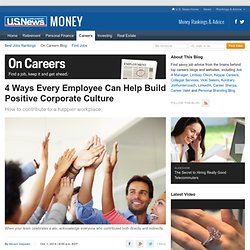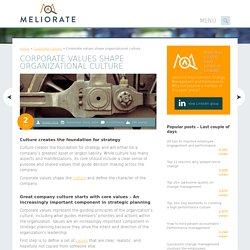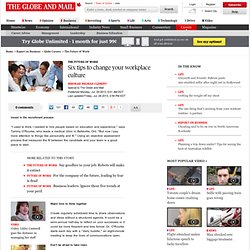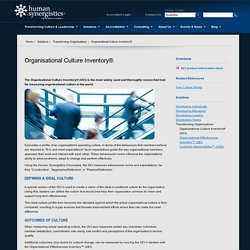

Culture Inhales Strategy for Breakfast... Then Spits it Out.
CHANGING ORGANIZATIONAL CULTURE FOR THE NEW WORLD OF WORK. Analysis of the Role Leadership Plays in Shaping an Organizational Culture. Power is a key component to leadership because it allows various leaders the ability to influence their followers, giving them the ability to affect the beliefs, attitudes, and courses of action of these groups (Northouse, 2013).

In influencing organizational culture, these beliefs, attitudes, and courses of action promote healthy organizations. 9 Leadership Steps For Corporate Culture Change. Top 5+ key elements in shaping company culture. Many leaders spend a lot of time talking about company culture: What does it take to create the right kind of culture?

How can you maintain that culture? How to build an organization that is fit for the future? But still many organizations treat the creation, maintenance, and periodic updating of their cultures in a cavalier manner. There’s an old joke about a CEO who attended a presentation on change management and corporate culture and then asked his head of HR to: Get me one of those things Of course it sounds ludicrous – but like most jokes, this story is based in truth.
Most senior managers struggle with culture because it’s so difficult to define. 4 Ways Every Employee Can Help Build Positive Corporate Culture. In the high-pressure world where many people work, executives, managers and employees sometimes fail to focus on how to improve corporate culture, which often takes a back seat to a focus on billable hours and producing profits.

Bruce Madnick, managing partner of top-50 accounting firm Friedman LLP, believes a positive work culture is key and thinks everyone can contribute to it. If you’re interested in helping create a positive, sharing and transparent culture, here are Madnick’s top tips to stand out in the crowd: 1. Be quick to share credit when something goes well. Have you heard the quote: “Leaders take all the blame and give away all the credit”?
How can you inspire a culture where the organization values and acknowledges each person’s role, including those who keep the office running or make fresh coffee each day? 2. At many companies, it is the employees – not partners or senior managers – who set the bar for community service activity. 3. Bluepoint Leadership Development. Corporate values shape organizational culture. Culture creates the foundation for strategy Culture creates the foundation for strategy and will either be a company’s greatest asset or largest liability.

While culture has many aspects and manifestations, its core should include a clear sense of purpose and shared values that guide decision making across the company. Corporate values shape the culture and define the character of the company. Great company culture starts with core values – An increasingly important component in strategic planning Corporate values represent the guiding principles of the organization’s culture, including what guides members’ priorities and actions within the organization. First step is to define a set of values that are clear, realistic, and hopefully not copied from someone else.
The Values-Driven Organization: Unleashing Human Potential for Performance and Profit: Richard Barrett: 9780415815031: Amazon.com: Books. The Premier Workplace Culture Educational Site where the top workplace culture experts in the world share their insights. Mindful of organizational culture norms. Organizational Culture Types. Three Steps to a High-Performance Culture - Carolyn Dewar and Scott Keller. By Carolyn Dewar and Scott Keller | 10:52 AM January 26, 2012 Senior executives tend to think about corporate culture as a topic that’s hard to measure and hard to change.

As a result, many choose not to invest in it despite all the evidence that, when skillfully managed, culture can be a powerful and enduring source of competitive advantage. ANZ Bank offers an example: a decade ago, the bank embarked on an effort described as a “unique plan of eschewing traditional growth strategies and recasting the culture of the bank to lift efficiency and earnings.” In the initial two years, the share of employees having the sense that ANZ “lived its values” went from 20 to 80 percent, and the share seeing “productivity in meetings” from 61 to 91 percent, with similar rises in the shares seeing “openness and honesty” and a “can-do culture.”
In parallel, revenue per employee increased 89 percent and the bank overtook its peers in total returns to shareholders and customer satisfaction. Culture Change Planner. A Sense of Community, a Shared Vision, and a Positive Cultu. Aligning Organizational Culture through Team Learning. Six tips to change your workplace culture. Invest in the recruitment process “I used to think I needed to hire people based on education and experience,” says Tammy O’Rourke, who leads a medical clinic in Belleville, Ont.

“But now I pay more attention to things like personality and fit.” Using an objective assessment process that measures the fit between the candidate and your team is a good place to start. Kurt Lewin three step change theory model » RapidBI-Mgt, Leaders. Introduction The Kurt Lewin change theory model is based around a 3-step process (Unfreeze-Change-Freeze) that provides a high-level approach to change. It gives a manager or other change agent a framework to implement a change effort, which is always very sensitive and must be made as seamless as possible. The Kurt Lewin model can help a leader do the following three steps: ActionResearch - Research Topics.
Center for Collaborative Action Research. Action Research Websites and Journals (updated Sep, 2017) Action Research Network of the Americas - ARNA Action Research for School Counselors Action Research SIG - AERA Action Research - CCAR Interact (for sharing teaching strategies) Action Learning, Action Research Association (ALARA)

Action research. Contents: introduction · origins · the decline and rediscovery of action research · conclusion · further reading · how to cite this article. see, also: research for practice.

In the literature, discussion of action research tends to fall into two distinctive camps. The British tradition – especially that linked to education – tends to view action research as research oriented toward the enhancement of direct practice. Action Research @ actionresearch.net. Feedback & Opinions on Workplace Trust. The best workplaces understand the factors that are truly valued by their people.

They perpetuate policies, practices and behaviors that strengthen the employee-manager relationship. Employee retention improves, mitigating the costs of continual re-hiring of personnel. Great Place to Work’s® expertise in organizational culture and leadership coaching helps transform companies into great workplaces by uncovering areas of improvement and by helping companies to develop practices, policies and behaviors that build credibility, respect and fairness into the culture of the workplace. Trust Index© Employee Survey What are your employees' perceptions of your workplace? Organisational Culture Inventory. The Organisational Culture Inventory® (OCI) is the most widely used and thoroughly researched tool for measuring organisational culture in the world.

It provides a profile of an organisation's operating culture, in terms of the behaviours that members believe are required to "fit in and meet expectations".Such expectations guide the way organisational members approach their work and interact with each other. These behavioural norms influence the organisations ability to solve problems, adapt to change and perform effectively. Using the Human Synergistics Circumplex, the OCI measures behavioural norms and expectations, be they ‘Constructive’, ‘Aggressive/Defensive’ or ‘Passive/Defensive’. Use These 14 Questions for a Corporate Culture Audit. Culture plays a big role in the health of an organization. Leaders need to foster a culture that supports the company’s objectives and keeps employees happy.
In a merger situation, integrating cultures is very important to deal success. But corporate culture often appears invisible to the people immersed in it. If you’re developing a strategy for your social intranet or anticipating a merger, you may be considering hiring a professional to conduct a corporate culture audit. Here are some questions you can use yourself as a mini-audit to help you see your company’s culture more clearly. How are things done around here?